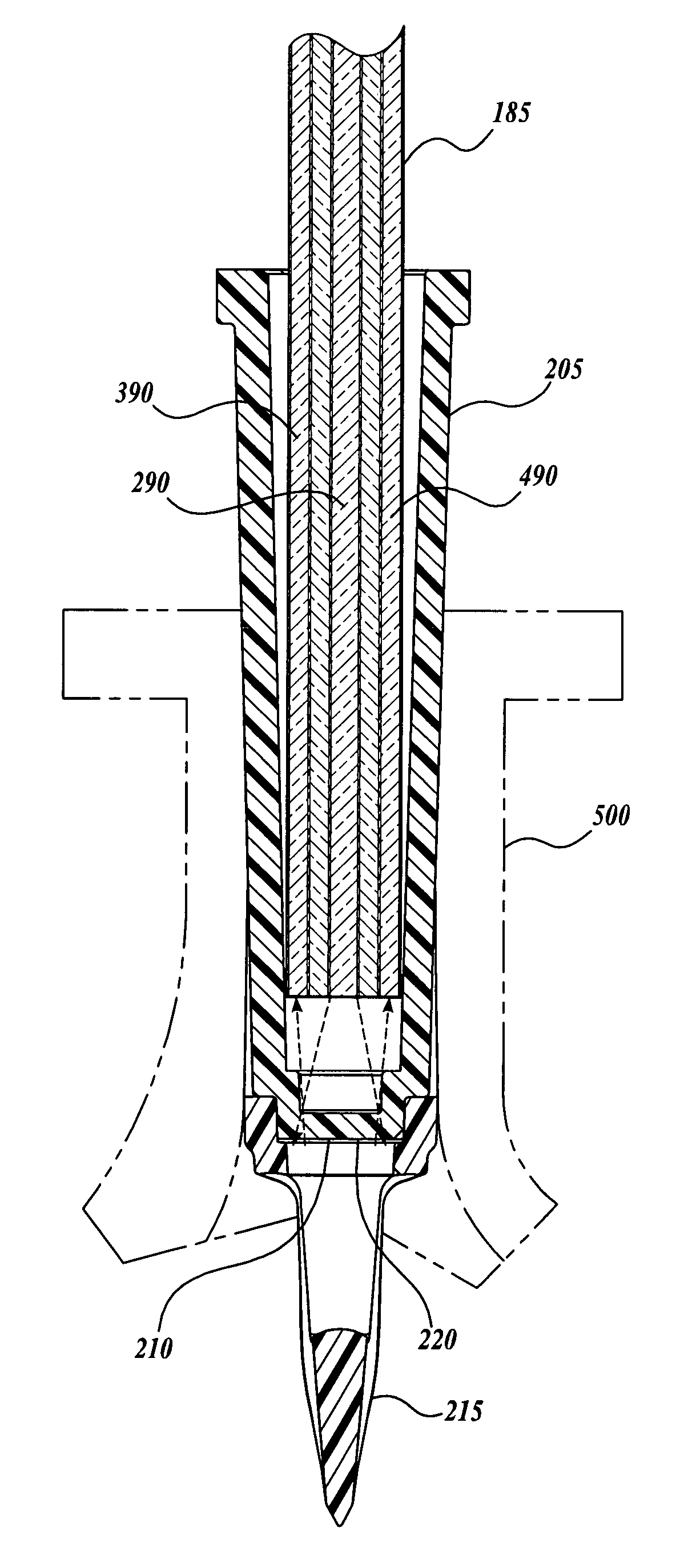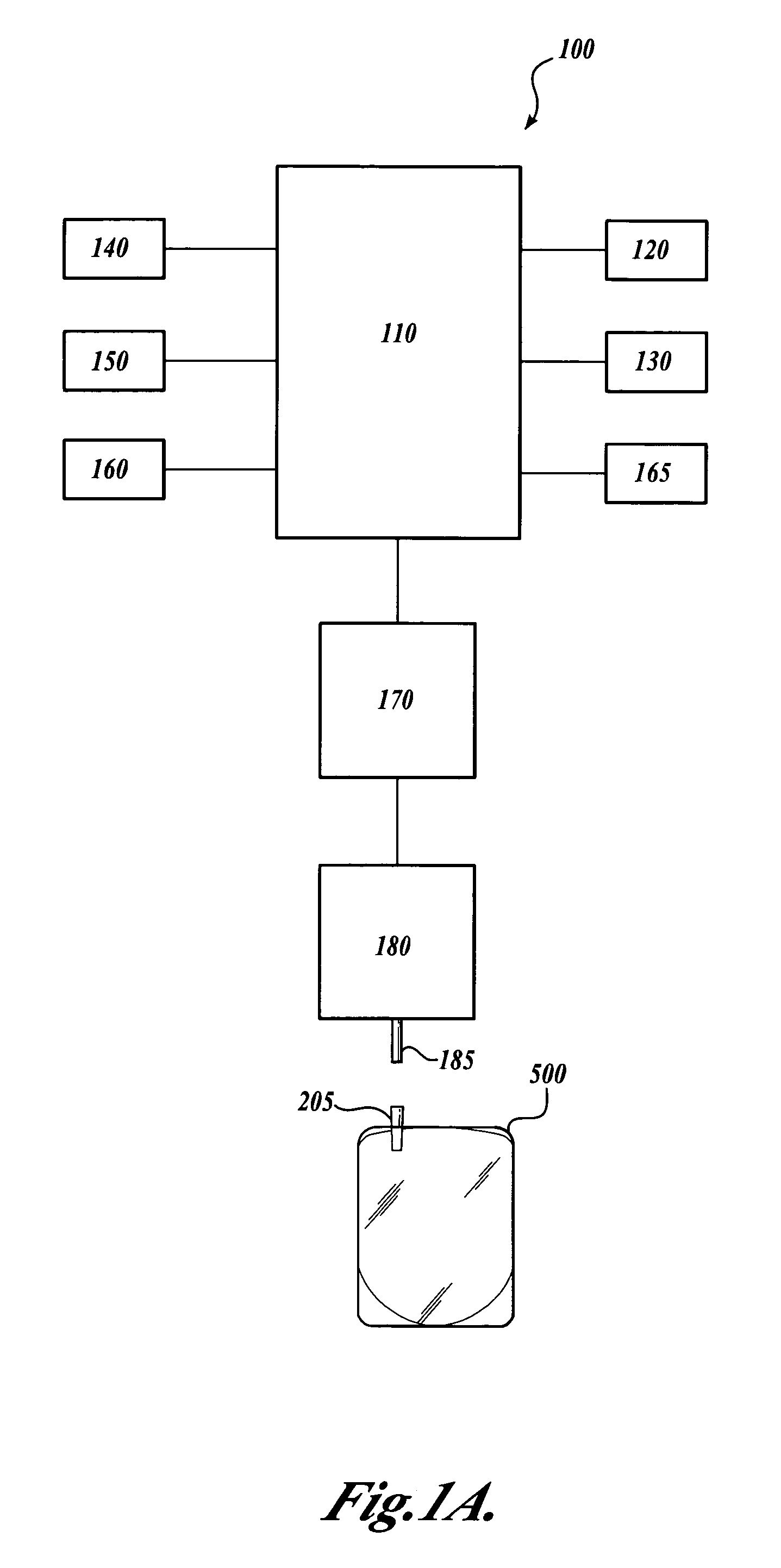Fluorescent pH detector system and related methods
a fluorescent ph detector and detector technology, applied in the field of fluorescent ph detectors, can solve the problems of color change that is difficult to distinguish accurately, does not provide quantitative reading, and is easy to use indicators
- Summary
- Abstract
- Description
- Claims
- Application Information
AI Technical Summary
Benefits of technology
Problems solved by technology
Method used
Image
Examples
example 1
The Manufacture of a Vessel Incorporating a Representative Substrate-Immobilized Fluorescent Species
[0191] Referring to FIG. 5B, sealed vessel 500 is manufactured from PVC. PVC material is compounded with a number of additives, for example, plasticizers, stabilizers, and lubricants. The formulation is used for making bags and tubes. The compounded PVC is extruded through a die for converting the plasticized material into sheet form. The extruded sheet, after slitting, is cut into the desired size and sent to the welding section. The donor and transfer tubings are made by extrusion of similar PVC compounds. The tubes are then cut to the appropriate length and sent to the welding section. The components, such as transfusion ports, needle covers, and clamp, are produced by injection molding. The components are ultrasonically cleaned and dried in a drying oven.
[0192] Welding. The blood bags are fabricated by a high frequency welding technique. Sized PVC sheets are placed between elect...
example 2
The Incorporation of a Representative Substrate-Immobilized Fluorescent Species into a Sealed Vessel
[0193] Referring to FIG. 5A, sealed vessel 500 includes a plurality of vessel ports 510. Port assembly 202 resides in vessel port 510A after insertion. The port assembly 202 (FIGS. 4A-4C) is manufactured from injection molded Lexan parts (205 and 215) and a 3.53 mm ( 9 / 64 inch) diameter nitrocellulose disc with immobilized fluorescent species (220). The port assembly is held together by friction fit or can be glued in place. The port assembly is inserted through the septum seal inside port 510A by puncturing the seal with the spiked tip. Alternatively, the seal can be pre-punctured with a separate spike tool. The insertion of the port assembly can be performed on either empty or platelet filled bags, but in either case, aseptic methods should be used to avoid possible contamination of the bag contents. The port assembly is held in the port by friction fit or can be glued in place. Ve...
example 3
Fluorescence and pH Properties of Representative SNAFL Analogs: pKa Determination
[0194] Instrumentation. Fluorescence versus pH of various SNAFL free acids were compared using an Ocean Optics USB2000 fiber optic spectrometer and a tungsten halogen light source (part number HL-2000 FHSA). The light source was equipped with a linear variable filter that allowed the wavelength and shape of the excitation beam to be adjusted. The excitation wavelength was adjusted by using a blank cuvette to the absorbance max of the fluorophore (see Table 1). A cuvette holder (part number CUV-FL-DA) was directly attached to the light source and a fiber optic cable directed emitted light to the spectrometer. Excitation conditions are reported for each fluorescence spectrum (3000 msec irradiation at the indicated wavelength). Spectral data were collected on a personal computer using the Ocean Optics software and overlays of different spectra were captured.
[0195] Sample preparation. SNAFL-1 was purchase...
PUM
| Property | Measurement | Unit |
|---|---|---|
| pKa | aaaaa | aaaaa |
| pKa | aaaaa | aaaaa |
| pKa | aaaaa | aaaaa |
Abstract
Description
Claims
Application Information
 Login to View More
Login to View More - R&D
- Intellectual Property
- Life Sciences
- Materials
- Tech Scout
- Unparalleled Data Quality
- Higher Quality Content
- 60% Fewer Hallucinations
Browse by: Latest US Patents, China's latest patents, Technical Efficacy Thesaurus, Application Domain, Technology Topic, Popular Technical Reports.
© 2025 PatSnap. All rights reserved.Legal|Privacy policy|Modern Slavery Act Transparency Statement|Sitemap|About US| Contact US: help@patsnap.com



